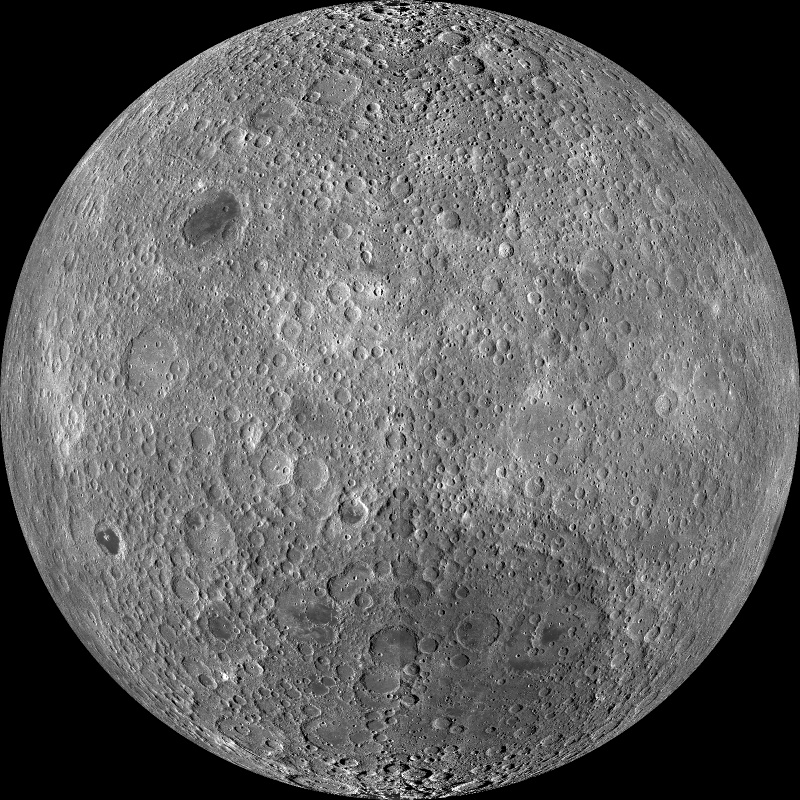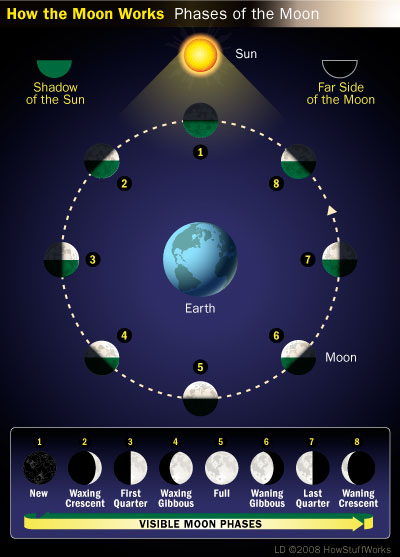Another semester is upon me and my continuing pursuit of a degree. This fall I’m seeking my science lab course credit so I decided to enroll in something I can easily get excited about: Astronomy
The following post begins a series of weekly discussion topics I’m required to choose and post to my online Introduction to Astronomy class discussion board. Since the formatting is very similar to that employed here at my blog, I’ll draft and publish my topics here as well. Feel free to comment or ask questions. I’ll do my best to answer or at least point you in the right direction.
Near and Far, Light and Dark; the Many Sides of Our Moon
Yin and yang can be thought of as complementary (rather than opposing) forces that interact to form a dynamic system in which the whole is greater than the assembled parts. Everything has both yin and yang aspects (for instance, shadow cannot exist without light).[1]
The moon’s rotation (axial spin) matches its revolution (orbit), also known as a synchronous rotation or tidally locked. This results in the same side, the near side, always facing towards Earth. Until 1959, humans had no idea what the far side of the moon looked like.[2] NASA’s LRO (Lunar Reconnaissance Orbiter) took over 15,000 images of the lunar surface between November 2009 and February 2011, assembled into a sharp mosaic image featured on APOD (Astronomy Picture of the Day) December 30, 2016.[3]

Both the near and far sides of the moon receive light and experience darkness. The only time the far side of the moon is also the dark side of the moon is when the moon appears full to those of us observing from Earth. Moon phases appear to us as a slow progression of the day and night times of the Moon as we follow the progression of the terminator, the boundary between the bright and shadowed regions.[4]

I selected this discussion topic because I always feel connected to the moon. Every morning when I leave for work, the first thing I look for once I’m on the road is the moon, at least when it’s waning as it approaches a new moon, like it did last week just before the total eclipse on the 21st. After the new moon, I keep an eye out for it on my drive home or in the evening when I’m walking my dogs, as it waxes towards a full moon. Tonight the moon is waxing gibbous in the southwest as I drift off to sleep. During the winter months, I attempt to see the youngest new moon (first sliver of a crescent within 24 hours of being a new moon) or the oldest moon (last sliver of a crescent within 24 hours before becoming a new moon). At this latitude (39 degrees North) and elevation (850 feet), the only time the skies or clear enough and free of humidity is during the cold crisp winter months. I keep a pair of binoculars handy as it is quite difficult to pick out that tiny sliver of a moon from the sky-glow of the rising (or setting) sun.
I find it fascinating that the Moon only shows us one face, perpetually locked in a starting contest I can never hope to win. Imagine if our eternal dance partner tripped or grew tired and slowly wandered out of sync, gradually showing us tantalizing bits of her hidden side. In the beginning, the Moon wasn’t synchronized with the Earth. The mutual attraction between Earth and Moon, what we call gravity, pulls on Earth’s oceans and on the Moon’s crust, creating a tidal bulge straining towards Earth. Over the eons, the Moon’s rotation slowed due to the tidal friction created by the Earth’s pull, until it became tidally locked, forever showing the same Moon face to Earth.[5]
What did Pink Floyd have to say about the dark side of the Moon?[6]
At the end of the album “Dark Side of the Moon” by Pink Floyd, there is a voiceover that actually says “There is no dark side of the moon. As a matter of fact, it’s all dark. The only thing that makes it look alight is the sun.”[7]
References:
[1] Yin and yang. (2017, August 13). In Wikipedia, The Free Encyclopedia. Retrieved 00:24, August 31, 2017, from https://en.wikipedia.org/w/index.php?title=Yin_and_yang&oldid=795390460
[2] Dunbar, B. (n.d.). The Far Side of the Moon — And All the Way Around. Retrieved August 30, 2017, from https://www.nasa.gov/mission_pages/LRO/news/lro-farside.html
[3] (n.d.). Retrieved August 30, 2017, from https://apod.nasa.gov/apod/ap161230.html
[4] Dark Side of the Moon | Watch the Skies. (2011, July 28). Retrieved from https://blogs.nasa.gov/Watch_the_Skies/tag/dark-side-of-the-moon/
[5] Redd, N. T. (2014, February 28). Does the Moon Rotate?. Retrieved from https://www.space.com/24871-does-the-moon-rotate.html
[6] Comins, N. F. (2015). Discovering the Night Sky. In Discovering the Essential Universe (6th ed., p. 17). W.H. Freeman and Company.
[7] Plait, P. (2008). Phil Plait’s Bad Astronomy: Dark Side of the Moon. Retrieved from http://www.badastronomy.com/bad/misc/dark_side.html

One thought on “Lunar Yin Yang”
Comments are closed.